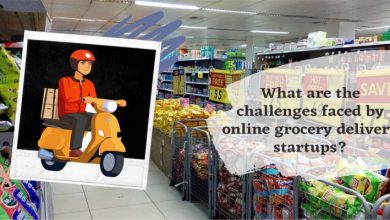Leverage Top 10 Amazing M-Commerce Features for Ultimate Business Growth in 2022

Does your mobile app have all the necessary features to sustain in this cutthroat mCommere era? With m-commerce leading more than three-fourth of all the online sales, a digital store owner can no longer ignore mobile commerce.
Mobile commerce (m-commerce) refers to online shopping done through smartphones or tablets. More generally, it means using mobile devices to buy or sell goods, pay bills, communicate with businesses, manage finances, and shop for services.
It’s an extension of e-commerce or electronic commerce. As per Statista’s 2021 report, mobile commerce worldwide holds 72.9% of all eCommerce sales. The infographic below offers insights into the growing popularity of mobile commerce over the years from 2016 to 2021.

Let’s look at some of the notable stats about mobile commerce that shows it is the present and the invincible future of eCommerce worldwide:
Mobile Commerce Stats
- Mobile retail revenue in the U.S stands at 338.03 billion U.S dollars in the U.S in 2020. (Source: Statista)
- The number of smartphone users is to reach 6567 million in 2022. (Source: Statista)
- Digital or mobile wallets will reach a whopping 33.4% popularity among preferred modes of payment worldwide by 2025. (Source: Statista)
- Mobile commerce already holds more than two-thirds of eCommerce, with an approximate value of 72.9%. (Source: Statista)
- The mobile payment market holds a compound annual growth rate of 35.35% from 2022 to 2035. (Source: Grand View Research)
With such a flourishing market, it’s exciting to think about how M-commerce will be in just six years. In fact Larry Page, the co-founder of Google, says:
“Most of us carry at least one device all the time, every day. In fact, many of us might feel naked without our smartphones. It’s hardly surprising mobile search queries, and mobile commerce are growing dramatically across the world.”
In my opinion, it’s not far when eCommerce will literally mean m-commerce. Moreover, for the eCommerce consumers, it’s already true. As an online store owner, it’s essential for you to keep track of what’s the latest in mobile commerce, to ensure high standards. Here are eleven features that will shape M-commerce in 2022 and some best practices for reaching consumers in this fast-paced environment.
Effective 10 Feature that Will Give Best Face to M-Commerce
Dynamic Pricing for Maximizing Profits
Shoppers nowadays increasingly take to mobile devices to check prices on products. It has led to brands relying on real-time pricing data from marketplaces like Amazon to determine suitable charges for items. If a competitor is charging less for an article or customers demand a lower price, a brand could change its price without ever shipping a product.

Source: Statista- Dynamic Pricing
This process is called dynamic pricing, and it’s already been adopted by brands like Whole Foods and Warby Parker. Dynamic pricing ensures that you’re always getting your maximum profit on every sale. Moreover, it lets customers constantly check your website to find out what you’re charging.
Personalization based on User Data

The good news for retailers is that, increasingly, consumers are willing to provide information. The bad news is that, increasingly, consumers want something from you in return. To succeed going forward, brands must find a way to offer personalized shopping experiences while still providing excellent service.
Amazon has pioneered an effective strategy. They deliver personalized recommendations on their site through their recommendations platform. It also offers free shipping to customers by encouraging them to join Amazon Prime, which offers myriad additional benefits beyond next-day delivery.
If your brand can make personalization part of its offering (rather than just a little ribbon at checkout), it will help drive customer loyalty while boosting sales.
Closer Integration With Offline Retail Stores
Consumers have a growing appetite for online orders to be delivered to their doorstep. But, why would someone who’s bought something online order it again when they can get it quicker and more easily at a physical retail store?
In 2022, ecommerce businesses can expect retail shops to play a viable role in the supply chain. Retail shops can offer click & collect services that allow consumers to purchase items on mobile devices and pick them up from physical stores—just like you would if you shopped in-store.
It will become more convenient than driving across town and standing in line because everyone wants instant gratification, especially when purchasing things that are practical or need replacing regularly.
So, the convenience of buying online will remain, but people will continue using both channels for shopping.
Seamless Payments Integration into the UX
Your customers will expect to make a payment at every stage of their shopping journey, so integrating payments into your UX is vital. We’re not just talking about payments integration. We’re talking about offering merchants a variety of payment methods—including seamless and secure mobile payments.
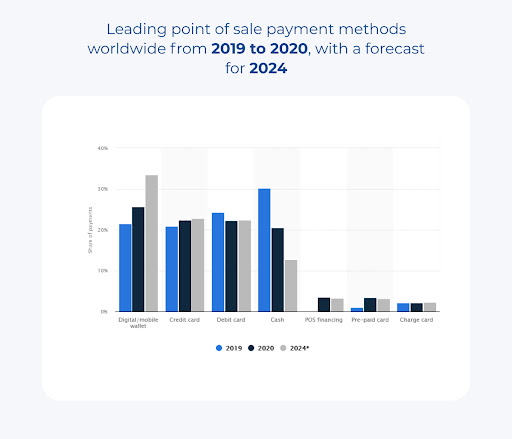
Source: Statista- Most Popular Payment Mode
In addition, always consider what happens when a user has to share their financial information:
- Is it easy and quick?
- Does it pass their test?
By answering these questions, you can create a seamless experience that will have your customers coming back again and again.
Innovative Targeting Methods of Marketing Campaigns
With so many new retail channels available, you need a way to target your sales and marketing campaigns at individuals. Use big data to figure out how you can reach customers with offers that are relevant to them. Not only will you boost conversions for your products and services, but you’ll also get better results from your sales and marketing budgets.
Rather than scattergun approaches to acquiring users, think about going deeper—by identifying people based on their behavior.
- Who are your customers?
- What do they like?
- Why do they buy things?
- What can be done to provide them with what they want before they know they want it?
- How do we get there from here?
You should answer all these questions as early as possible if you have any hope of making it in an increasingly crowded market.
Consistent High UX Across All Channels
As mobile becomes a more significant piece of your business, you’ll need to design for it. And that means making sure your app experience is seamless across all channels—your website, mobile site, native app, etc.
A consistent user experience allows users to quickly move from one channel to another without feeling disoriented or confused. Many businesses have multiple apps with different interfaces.
However, designing an app for maximum growth and profit potential makes sense to make everything look and feel consistent, so users are less likely to be deterred by an app overload.
Also worth considering: consistency in messaging between channels makes your overall message more coherent and therefore more powerful. Hire mobile app developers that ensure consistency in your eCommerce business across multiple screen sizes.
Focus on New Use Cases
Mobile commerce has been driven by new use cases like flash sales, location-based coupons, and mobile payments in recent years. But by 2022, we’ll see even more m-commerce services that help consumers find products based on their needs (like healthcare and grocery), rather than just shopping for items they want to buy.
Likewise, traditional retailers might begin offering localized deals based on customer history, while digital brands will personalize offers based on purchase history and social data.
Leveraging Machine Learning And Artificial Intelligence to Guide Users Through The Buying Process
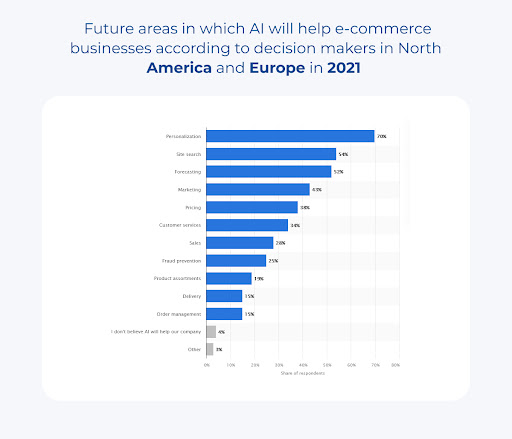
Source: Statista- Future areas in which AI will help e-commerce businesses
To make ecommerce a seamless experience, you have to think about every aspect of what a shopper will go through when searching for, browsing, and buying a product. From that first click on your website to when they sign up for mailing lists and interact with social media.
It is no longer enough to offer up an online storefront—you need effective web design, user interaction, recommendation engines, and more. Machine Learning (ML) and Artificial Intelligence (AI) will be essential in providing users with an optimal shopping experience.
If you want your m-commerce business to succeed, you’ll need one of these two game-changing technologies running on your website as soon as possible.
Direct Communication Between Brands and Customers
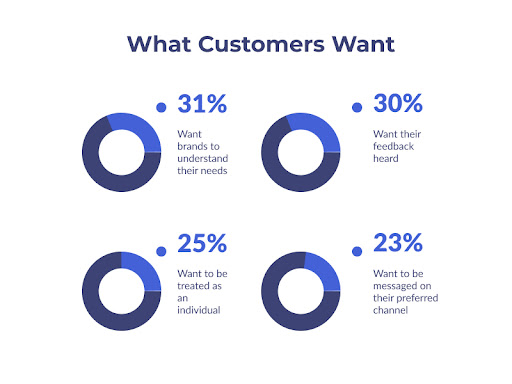
As mobile commerce grows, so will brands’ ability to communicate directly with customers. Earlier, brands were primarily using text messages to contact and interact. But now, it is commonplace for brands to send promotional materials, discounts, and even offers directly through their mobile apps.
Research shows that consumers love using their apps as a direct connection to retailers. Notably, not only does it make communication more accessible but also more seamless and enjoyable.
We can expect more & more business brands to follow suit as they jump on board with e-commerce opportunities.
Augmented Reality Enhancing the Mobile Commerce Experience
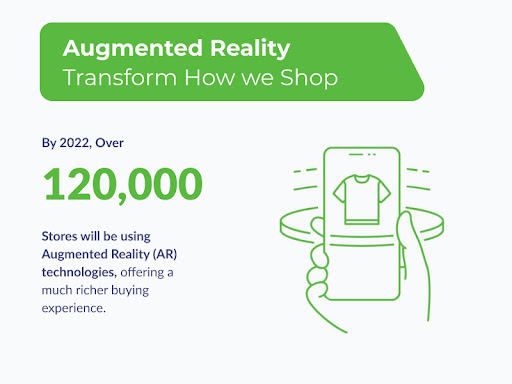 A new trend has emerged that might redefine m-commerce: Augmented Reality. The buzz surrounding digital technologies like Snapchat’s Spectacles which are one of many AR solutions at various stages of development today—suggests that these innovations could be more ubiquitous than we might expect.
A new trend has emerged that might redefine m-commerce: Augmented Reality. The buzz surrounding digital technologies like Snapchat’s Spectacles which are one of many AR solutions at various stages of development today—suggests that these innovations could be more ubiquitous than we might expect.
More importantly, these developments point to increased consumer expectations that experiences should feel immersive. Given how ingrained smartphones and tablets have become into our daily lives, it makes sense for e-tailers to capitalize on consumers’ desire for something more.
Some of the renowned brands leveraging AR for excellent user experience include the name of IKEA, Sephora, LensKart, etc.
Parting Words
In many ways, m-commerce has already come of age. It has evolved from a checkout channel to a sophisticated technology that enables consumers to shop from their mobile devices in diverse ways.
This trend is evident with large retailers such as Walmart leveraging it for last-mile delivery and small merchants using it for sales and promotions, expect much more of that in 2022 and beyond.
With m-Commerce leading the retail industry by storm, no business can survive by ignoring the technology. Connect with a leading mobile app development company to integrate emerging m-commerce features in your digital store seamlessly.
Read More Here – Top Reasons Why You Need A Mobile App Development Company



